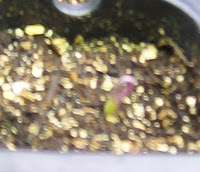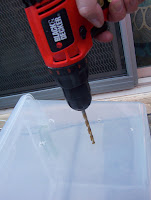
rare clouds over our backyard

rare clouds over our backyard


 leaves on my Better Boy tomato plant had disappeared. I quickly decided that some sort of hungry pest must be eating them, but when I looked I couldn't find anything unusual. Then, as I walked by yesterday evening, I happened to glance up and discovered the culprit. A huge hornworm was feasting on the poor plant. It was so large that I don't know how I missed finding it earlier in the day. In just the few hours between my first unsuccessful search and finding the offending and well-fed creature, it had stripped an entire limb of the plant. These things can really eat!
leaves on my Better Boy tomato plant had disappeared. I quickly decided that some sort of hungry pest must be eating them, but when I looked I couldn't find anything unusual. Then, as I walked by yesterday evening, I happened to glance up and discovered the culprit. A huge hornworm was feasting on the poor plant. It was so large that I don't know how I missed finding it earlier in the day. In just the few hours between my first unsuccessful search and finding the offending and well-fed creature, it had stripped an entire limb of the plant. These things can really eat! 

a look inside the compost bin
A few days ago I posted that five of the six Black Prince tomato seeds that I harvested and planted had sprouted. The sixth joined the other five shortly after the that update post. They seem to be doing well.

 .
.
 t surroundings. While the desert can, at times, be a strikingly beautiful place, it can also lack the vibrancy and vitality accompanying the blooms and greenery of more hospitable climates. Beyond the ambers, oranges, and black painted upon its mountains by early morning Sun and late evening shadows, the abundance of brown dirt, brown rocks, and brown shrubs at all times intervening can grow both monotonous and disheartening. Here are just a few non-vegetable plants that we've sown in hopes of adding a little color to our small corner of the desert.
t surroundings. While the desert can, at times, be a strikingly beautiful place, it can also lack the vibrancy and vitality accompanying the blooms and greenery of more hospitable climates. Beyond the ambers, oranges, and black painted upon its mountains by early morning Sun and late evening shadows, the abundance of brown dirt, brown rocks, and brown shrubs at all times intervening can grow both monotonous and disheartening. Here are just a few non-vegetable plants that we've sown in hopes of adding a little color to our small corner of the desert.




A very hot plant

After cooling down for a couple of hours

Okra
Sunmaster (left), recently planted Heatwave (right)
Heatwave
Lemon Boy
Black Prince
Tabasco Pepper
Jalapeno
Basil (second planting)
 seed and use it to replace my last and very poor looking Better Boy. I'm doing this because the Better Boy appears to be losing ground rapidly, while the Black Prince continues to thrive and put on fruit. Hopefully, the time it takes the Siberian heirloom's seeds to grow into transplantable seedlings will give the few (3) small tomatoes on the Better Boy a chance to ripen. That is, of course, assuming that the plant survives that long.
seed and use it to replace my last and very poor looking Better Boy. I'm doing this because the Better Boy appears to be losing ground rapidly, while the Black Prince continues to thrive and put on fruit. Hopefully, the time it takes the Siberian heirloom's seeds to grow into transplantable seedlings will give the few (3) small tomatoes on the Better Boy a chance to ripen. That is, of course, assuming that the plant survives that long. coating from the seeds and some claim that it rids the seeds of any diseases that might be present. After the seeds soak for a few days, the top of the water will look pretty scummy. This is a good thing, as it lets you know the fermentation is taking place. Now remove the seeds, rinse them off, and spread them out one by one on a paper towel. Place the paper towel in an out of the way place and allow the seeds to dry for several more days (3 or 4 should do it). Once dry, they are ready to store or plant.
coating from the seeds and some claim that it rids the seeds of any diseases that might be present. After the seeds soak for a few days, the top of the water will look pretty scummy. This is a good thing, as it lets you know the fermentation is taking place. Now remove the seeds, rinse them off, and spread them out one by one on a paper towel. Place the paper towel in an out of the way place and allow the seeds to dry for several more days (3 or 4 should do it). Once dry, they are ready to store or plant.  After getting home with my new container, I proceeded to take it out back and drill two rows of 1/4" holes around it spaced about 4 inches apart (both between the holes and between the rows). These holes are intended to provide adequate airflow so the much needed bacteria can grow and do its job breaking down the compost material. Also, I drilled a few holes in the bottom for drainage of excess water. As the compost breaks down, I want to keep it warm and moist, but not soaking wet.
After getting home with my new container, I proceeded to take it out back and drill two rows of 1/4" holes around it spaced about 4 inches apart (both between the holes and between the rows). These holes are intended to provide adequate airflow so the much needed bacteria can grow and do its job breaking down the compost material. Also, I drilled a few holes in the bottom for drainage of excess water. As the compost breaks down, I want to keep it warm and moist, but not soaking wet. 
 ded some old shredded leaves, stems, dirt, crushed eggshells, outdated veggies, and even a little paper. I then wet the contents down mixed it all thoroughly and placed the lid on top. From this point on, I'll add material as it becomes available, sprinkle in a little water as needed to keep moist, and stir/shake the contents up once a week or so. I'll keep you all updated over the next few weeks to let you know how my dirt is coming along!
ded some old shredded leaves, stems, dirt, crushed eggshells, outdated veggies, and even a little paper. I then wet the contents down mixed it all thoroughly and placed the lid on top. From this point on, I'll add material as it becomes available, sprinkle in a little water as needed to keep moist, and stir/shake the contents up once a week or so. I'll keep you all updated over the next few weeks to let you know how my dirt is coming along!
 ge and crisp delicacy, I find myself tormented daily by the fact that I can't see how big they are! So, you know the routine....each day I'm sticking my finger down into the dirt around their stems, carefully probing and digging until I can see the orange tops of the roots. But this glimpse of orange only makes matters worse, as I now know growth is taking place but have no idea how much. And my carrot growing mind takes off: Is it ready? I should just pull one and see.... No, wait a couple of more weeks and make sure....If you pull it you can't put it back. Oh the indecision!
ge and crisp delicacy, I find myself tormented daily by the fact that I can't see how big they are! So, you know the routine....each day I'm sticking my finger down into the dirt around their stems, carefully probing and digging until I can see the orange tops of the roots. But this glimpse of orange only makes matters worse, as I now know growth is taking place but have no idea how much. And my carrot growing mind takes off: Is it ready? I should just pull one and see.... No, wait a couple of more weeks and make sure....If you pull it you can't put it back. Oh the indecision!


I'm assuming that some sort of early blight infected the plants or that they just couldn't overcome a short stretch of 105 degree weather we had in mid-May.
 So, a couple of days ago I decided to pull the plug on the smallest Better Boys, replacing one with a Heatwave and the other with a Sunmaster. While it may be too late for these to produce in the Summer, the mature plants will hopefully provide a good crop in the fall. I'm still undecided on whether to replace the taller plant immediately or leave it a while in hopes that its three tomatoes ripen.
So, a couple of days ago I decided to pull the plug on the smallest Better Boys, replacing one with a Heatwave and the other with a Sunmaster. While it may be too late for these to produce in the Summer, the mature plants will hopefully provide a good crop in the fall. I'm still undecided on whether to replace the taller plant immediately or leave it a while in hopes that its three tomatoes ripen.


And earlier today, my wife stopped by a local In and Out Burger joint only to find that they too had sworn off tomatoes. It is also being reported that Winn Dixie grocery stores are removing certain varieties of tomatoes from their shelves.




 Okra, tomatoes, and herbs
Okra, tomatoes, and herbs